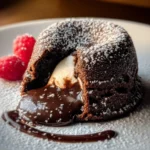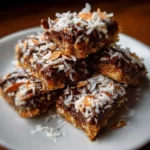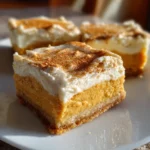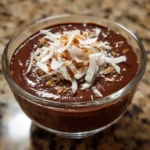Of all the late-night cravings that can strike, the sudden, desperate need for something warm, rich, and intensely chocolatey is perhaps the most powerful. I remember one such evening, scrolling aimlessly, when the craving hit me like a ton of bricks. I didn’t want a simple chocolate bar; I wanted a dessert. Something decadent and gooey, but the thought of preheating the oven, dirtying a dozen bowls, and waiting for 30 minutes felt like an insurmountable task. That’s when I remembered the magic of the microwave and the promise of a nearly-instant dessert. I tinkered with a few ideas and landed on this recipe for a Microwave Chocolate Lava Cake. The first time I made it, I was skeptical. Could a microwave truly produce something so luxurious in under five minutes? I watched through the small window as the batter puffed up around the edges. When the timer beeped, I let it sit for a moment, my heart pounding with anticipation. The first spoonful was a revelation. The cake was tender and moist, but breaking through to the center released a river of molten, liquid chocolate that coated my spoon. It was everything I had craved and more. It has since become our family’s go-to emergency dessert. My kids cheer when they see me grab a mug and the cocoa powder, and my husband, a notorious dessert snob, has even requested it over fancy, store-bought treats. It’s our little secret weapon for turning a mundane evening into a special occasion, proving that you don’t need an oven or an hour to create a moment of pure, chocolate-fueled bliss.
Ingredients
This recipe relies on simple pantry staples to create a remarkably decadent dessert. Each component plays a crucial role in achieving the perfect balance of a fluffy cake exterior and a gooey, molten interior. Ensure your ingredients are fresh for the best possible flavor and texture.
- All-Purpose Flour (4 tablespoons): This is the foundation of our cake, providing structure and stability. All-purpose flour is versatile and gives the cake a tender yet firm crumb that can contain the molten chocolate center without collapsing.
- Granulated Sugar (4 tablespoons): This provides the essential sweetness to balance the rich, sometimes bitter notes of the cocoa powder. Granulated sugar dissolves easily, ensuring a smooth texture without any graininess in the final product.
- Unsweetened Cocoa Powder (2 tablespoons): This is where the deep, intense chocolate flavor comes from. Using unsweetened powder gives you full control over the sweetness. For an even richer, darker cake, you can opt for Dutch-processed cocoa powder.
- Baking Powder (¼ teaspoon): This is our leavening agent. A small amount is all that’s needed to give the cake a light, airy lift in the microwave, preventing it from becoming dense and heavy.
- Pinch of Salt (⅛ teaspoon): Do not skip the salt! A tiny pinch doesn’t make the cake salty; instead, it dramatically enhances and brightens the chocolate flavor, making it taste more complex and satisfying.
- Milk (3 tablespoons): Milk adds necessary moisture and richness to the batter, contributing to a tender crumb. Whole milk will provide the richest result, but you can easily substitute it with 2% milk, almond milk, or soy milk.
- Vegetable Oil (3 tablespoons): Oil is the key to a supremely moist microwave cake. Unlike butter, which can sometimes make microwave cakes tough, oil guarantees a soft, tender texture every single time. Any neutral oil like canola or sunflower oil works perfectly.
- Vanilla Extract (½ teaspoon): Vanilla acts as a flavor enhancer, much like salt. It rounds out the chocolate flavor, adding a layer of aromatic warmth and complexity to the dessert.
- High-Quality Chocolate Chunks or Chips (1 ounce or about 2-3 tablespoons): This is the “lava” in our lava cake. Placing this in the center of the batter before cooking creates the signature molten core. Using a good quality chocolate bar chopped into chunks will yield a more luscious, fluid lava than standard chocolate chips, which often contain stabilizers to hold their shape. Dark or semi-sweet chocolate works best.
Instructions
Follow these steps carefully to ensure a perfect lava cake every time. The process is incredibly simple, but the key to success lies in not overmixing the batter and, most importantly, not overcooking the cake. Working quickly will also help the baking powder retain its leavening power.
Step 1: Prepare Your Mug
Select a standard-sized, microwave-safe mug (approximately 10-12 ounces). A larger mug is better than a smaller one to prevent the batter from overflowing as it cooks and rises. Generously grease the inside of the mug with butter, a small amount of oil, or non-stick cooking spray. This crucial step ensures that your cake will not stick to the sides, allowing you to either eat it directly from the mug or easily invert it onto a plate for a more elegant presentation.
Step 2: Combine the Dry Ingredients
In the prepared mug, add the all-purpose flour, granulated sugar, unsweetened cocoa powder, baking powder, and the pinch of salt. Use a small whisk or a fork to mix these dry ingredients together thoroughly. Make sure there are no visible lumps of cocoa powder or baking powder. This step is vital for an evenly flavored and evenly risen cake, preventing any bitter or salty pockets.
Step 3: Add the Wet Ingredients and Mix
Pour the milk, vegetable oil, and vanilla extract directly on top of the mixed dry ingredients in the mug. Using the same fork or small whisk, mix the wet and dry ingredients together until they are just combined. Scrape the bottom and sides of the mug to ensure everything is incorporated, but be very careful not to overmix. A few small lumps in the batter are perfectly fine. Overmixing will develop the gluten in the flour, resulting in a tough, rubbery cake instead of a tender one. The final batter should be smooth and have a consistency similar to thick pancake batter.
Step 4: Create the Molten Center
Take your ounce of high-quality chocolate chunks or chips and place them in the center of the batter. Gently press them down with your finger or a spoon so they are submerged just below the surface of the batter. This concentration of chocolate in the middle is what will melt into a glorious, gooey pool of lava as the cake cooks around it.
Step 5: Microwave to Perfection
Place the mug in the center of your microwave. The cooking time is the most critical and variable part of this recipe, as it depends entirely on your microwave’s wattage. For a standard 1000-watt microwave, cook on high for 70 to 90 seconds. If you have a more powerful microwave (1200+ watts), start with 60 seconds. For a lower wattage microwave (700-800 watts), you may need up to 2 minutes. The goal is for the edges of the cake to look set and cooked, while the very center still appears slightly wet and jiggly. It’s always better to undercook it slightly than to overcook it. You can always add 10 more seconds if needed, but you can’t undo an overcooked, rubbery cake.
Step 6: Rest and Serve
Carefully remove the mug from the microwave—it will be very hot! Let the lava cake rest on a heat-proof surface for at least 1-2 minutes. This resting period is essential. It allows the cake to finish cooking with its residual heat and lets the structure set up slightly, which is particularly important if you plan to invert it. After resting, you can enjoy it straight from the mug or run a knife around the edge and carefully turn it upside down onto a small plate to reveal the beautiful cake and its hidden molten treasure.
Nutrition Facts
This is an indulgent, single-serving dessert. The nutritional information is an approximation and can vary based on the specific ingredients used (e.g., type of milk, percentage of cocoa in the chocolate).
- Servings: 1 Lava Cake
- Calories per serving: Approximately 550-650 kcal
- Carbohydrates (approx. 75g): Primarily from the flour and sugar, carbohydrates provide the quick energy that makes this such a satisfying treat.
- Fat (approx. 30g): The oil and chocolate center are the main sources of fat, which is responsible for the cake’s moist texture and rich, decadent mouthfeel.
- Protein (approx. 8g): Sourced from the flour and milk, protein contributes to the cake’s structure.
- Sugar (approx. 45g): A significant portion of the carbohydrates is sugar, providing the sweetness that defines this as a dessert.
- Sodium (approx. 250mg): The small amount of added salt and baking powder contribute to the sodium content, which plays a key role in enhancing the overall flavor profile.
Preparation Time
This recipe is the epitome of a quick and easy dessert, designed for instant gratification. The total time from gathering your ingredients to taking your first delicious bite is well under 10 minutes, making it one of the fastest homemade desserts you can possibly create.
- Prep Time: 3-4 minutes. This includes gathering your pantry staples, measuring them out, and mixing the batter directly in the mug.
- Cook Time: 70-90 seconds. The microwave does the heavy lifting in a fraction of the time it would take an oven.
- Total Time: Approximately 5 minutes. It’s the perfect solution for a sudden dessert craving or an impressive last-minute treat for an unexpected guest.
How to Serve
While this Microwave Chocolate Lava Cake is magnificent on its own, the right accompaniments can elevate it from a simple mug cake to a gourmet dessert experience. The contrast between the warm, gooey cake and a cool, creamy topping is especially delightful. Here are some serving suggestions, from simple to sophisticated:
- The Classic Way: Straight from the Mug
- This is the easiest and coziest way to enjoy your creation. Just grab a spoon and dive right in. It’s perfect for a solo movie night on the couch.
- The Plated Presentation: Inverted
- For a more elegant look, let the cake rest for 2 minutes, then carefully run a thin knife or spatula around the inside edge of the mug to loosen it. Place a small plate over the top of the mug, and with one confident motion, flip them over together. Gently lift the mug away. The cake should slide out, ready to be decorated.
- Toppings and Accompaniments:
- Cool and Creamy Contrast:
- A scoop of high-quality vanilla bean ice cream melting slowly over the warm cake.
- A generous dollop of freshly whipped cream (lightly sweetened).
- A spoonful of tangy crème fraîche or Greek yogurt to cut through the richness.
- Coffee or mint chocolate chip ice cream for a flavorful twist.
- Fruity and Fresh:
- A handful of fresh raspberries or sliced strawberries adds a bright, tart counterpoint.
- A simple cherry compote or a spoonful of raspberry coulis.
- Sliced bananas and a drizzle of honey.
- Sauces and Drizzles:
- A drizzle of warm caramel or salted caramel sauce.
- An extra drizzle of chocolate syrup for the ultimate chocoholic.
- A spoonful of melted peanut butter or Biscoff spread.
- A Touch of Crunch and Texture:
- A sprinkle of flaky sea salt on top to make the chocolate flavor pop.
- Toasted chopped nuts like pecans, walnuts, or hazelnuts.
- A dusting of powdered sugar for a simple, elegant finish.
- Chocolate shavings or colorful sprinkles for a bit of fun.
- Cool and Creamy Contrast:
Additional Tips
Mastering this recipe is easy, but these eight tips will help you perfect your technique and customize the cake to your exact liking, ensuring flawless results every time.
- Know Your Microwave: This is the most important tip. Microwave wattages vary significantly. The first time you make this cake, watch it like a hawk. Note the exact time it takes to get set edges and a jiggly center. Write it down! This will be your magic number for all future lava cakes.
- The Right Mug Matters: Use a ceramic mug with straight sides if possible. A mug that is wider at the top than the bottom can sometimes cook unevenly. Ensure it’s large enough (10-12 oz) to allow the cake to rise without spilling over and creating a mess.
- Don’t Overmix the Batter: When combining the wet and dry ingredients, mix only until you no longer see streaks of flour. A few small lumps are perfectly acceptable and are preferable to an overmixed batter. Overmixing develops gluten, which is the number one cause of a tough, rubbery microwave cake.
- Quality Chocolate is Key for the “Lava”: For the molten center, use the best quality chocolate you have. A piece from a good dark or semi-sweet chocolate bar will melt into a much more fluid and luscious “lava” than standard chocolate chips, which contain emulsifiers to help them hold their shape when heated.
- Sift for a Smoother Batter: If you often find lumps of cocoa powder in your cakes, take an extra 30 seconds to sift the dry ingredients (flour, sugar, cocoa, baking powder, salt) together before adding the wet ingredients. This guarantees a perfectly smooth, homogenous batter.
- Adjust Sweetness to Your Taste: This recipe is a great starting point, but feel free to adjust it. If you prefer a darker, more bittersweet cake, reduce the sugar to 3 tablespoons. If you have a major sweet tooth, you can increase it slightly or use milk chocolate for the center.
- Easily Double the Recipe: This recipe is designed for one, but it’s incredibly easy to make for two. Simply prepare two separate mugs, each with its own batter. Do not try to double the ingredients in one large bowl and then divide it. Mixing the batter directly in each mug is faster and ensures correct proportions. Microwave them one at a time for best results.
- Use Room Temperature Milk: If you have the time, use milk that is at room temperature rather than straight from the fridge. Cold liquid can cause the oil to slightly solidify and make the batter harder to mix smoothly. Room temperature ingredients combine more easily and result in a more uniform texture.
FAQ Section
Here are answers to some of the most frequently asked questions about making a chocolate lava cake in the microwave.
1. Why was my lava cake dry and rubbery instead of soft and gooey?
This is almost always due to overcooking. Even 10 extra seconds in a powerful microwave can be the difference between a perfect molten cake and a tough, dry one. The next time you make it, reduce the cooking time by 15-20 seconds. The cake is done when the edges are set but the very center still looks soft and slightly underdone. Remember, it will continue to cook from residual heat as it rests.
2. Can I make this recipe gluten-free?
Yes, you can. For the best results, substitute the all-purpose flour with a high-quality “cup-for-cup” or “1:1” gluten-free baking flour blend. These blends typically contain xanthan gum, which helps provide the structure that gluten normally would. Do not simply substitute with a single-ingredient flour like almond or coconut flour, as the liquid ratios would need to be adjusted significantly.
3. Can I use melted butter instead of oil?
You can, but oil is generally recommended for microwave cakes. Oil is 100% fat and remains liquid at room temperature, which helps create and maintain a super moist texture. Butter contains water and milk solids, and when microwaved, it can sometimes lead to a slightly tougher or drier cake crumb. If you choose to use butter, use the same amount (3 tablespoons, melted).
4. My “lava” center wasn’t molten. What went wrong?
There are two likely culprits. First, you may have overcooked the cake, causing the center to cook through along with the edges. Try reducing the cook time. Second, you may not have used enough chocolate for the center, or you used chocolate chips that are designed to hold their shape. For a guaranteed river of lava, use a generous chunk (or two) from a good quality chocolate bar.
5. Can I prepare the batter in advance and store it in the fridge?
It is not recommended. The baking powder is activated as soon as it comes into contact with the liquid ingredients. If you let the batter sit for too long before cooking, the chemical reaction will fizzle out, and your cake will not rise properly. It will likely turn out dense and flat. Since the recipe only takes a few minutes to mix, it’s best to prepare it right before you want to eat it.
6. What is the best type of cocoa powder to use?
You can use either natural unsweetened cocoa powder or Dutch-processed cocoa powder. Natural cocoa powder has a more acidic, sharp chocolate flavor. Dutch-processed cocoa powder has been neutralized, resulting in a darker color and a smoother, richer, less bitter flavor. For a truly decadent, deep chocolate cake, Dutch-processed is a fantastic choice.
7. Why did my cake batter overflow or “explode” in the microwave?
This happens for one of two reasons: your mug was too small, or you filled it too full. The batter will rise significantly as it cooks. Always use a standard 10-12 ounce mug and ensure the batter doesn’t fill it more than halfway to two-thirds full to leave plenty of room for expansion.
8. Can I make this recipe without an egg?
Great news! This specific recipe is already designed to be egg-free. Many traditional cake recipes rely on eggs for binding, moisture, and leavening, but this recipe uses a careful balance of oil, milk, and baking powder to achieve a wonderfully soft and moist result without any eggs at all. This makes it a perfect dessert for those with egg allergies or for when you’ve simply run out of eggs.

Microwave Chocolate Lava Cake
Ingredients
This recipe relies on simple pantry staples to create a remarkably decadent dessert. Each component plays a crucial role in achieving the perfect balance of a fluffy cake exterior and a gooey, molten interior. Ensure your ingredients are fresh for the best possible flavor and texture.
- All-Purpose Flour (4 tablespoons): This is the foundation of our cake, providing structure and stability. All-purpose flour is versatile and gives the cake a tender yet firm crumb that can contain the molten chocolate center without collapsing.
- Granulated Sugar (4 tablespoons): This provides the essential sweetness to balance the rich, sometimes bitter notes of the cocoa powder. Granulated sugar dissolves easily, ensuring a smooth texture without any graininess in the final product.
- Unsweetened Cocoa Powder (2 tablespoons): This is where the deep, intense chocolate flavor comes from. Using unsweetened powder gives you full control over the sweetness. For an even richer, darker cake, you can opt for Dutch-processed cocoa powder.
- Baking Powder (¼ teaspoon): This is our leavening agent. A small amount is all that’s needed to give the cake a light, airy lift in the microwave, preventing it from becoming dense and heavy.
- Pinch of Salt (⅛ teaspoon): Do not skip the salt! A tiny pinch doesn’t make the cake salty; instead, it dramatically enhances and brightens the chocolate flavor, making it taste more complex and satisfying.
- Milk (3 tablespoons): Milk adds necessary moisture and richness to the batter, contributing to a tender crumb. Whole milk will provide the richest result, but you can easily substitute it with 2% milk, almond milk, or soy milk.
- Vegetable Oil (3 tablespoons): Oil is the key to a supremely moist microwave cake. Unlike butter, which can sometimes make microwave cakes tough, oil guarantees a soft, tender texture every single time. Any neutral oil like canola or sunflower oil works perfectly.
- Vanilla Extract (½ teaspoon): Vanilla acts as a flavor enhancer, much like salt. It rounds out the chocolate flavor, adding a layer of aromatic warmth and complexity to the dessert.
- High-Quality Chocolate Chunks or Chips (1 ounce or about 2-3 tablespoons): This is the “lava” in our lava cake. Placing this in the center of the batter before cooking creates the signature molten core. Using a good quality chocolate bar chopped into chunks will yield a more luscious, fluid lava than standard chocolate chips, which often contain stabilizers to hold their shape. Dark or semi-sweet chocolate works best.
Instructions
Follow these steps carefully to ensure a perfect lava cake every time. The process is incredibly simple, but the key to success lies in not overmixing the batter and, most importantly, not overcooking the cake. Working quickly will also help the baking powder retain its leavening power.
Step 1: Prepare Your Mug
Select a standard-sized, microwave-safe mug (approximately 10-12 ounces). A larger mug is better than a smaller one to prevent the batter from overflowing as it cooks and rises. Generously grease the inside of the mug with butter, a small amount of oil, or non-stick cooking spray. This crucial step ensures that your cake will not stick to the sides, allowing you to either eat it directly from the mug or easily invert it onto a plate for a more elegant presentation.
Step 2: Combine the Dry Ingredients
In the prepared mug, add the all-purpose flour, granulated sugar, unsweetened cocoa powder, baking powder, and the pinch of salt. Use a small whisk or a fork to mix these dry ingredients together thoroughly. Make sure there are no visible lumps of cocoa powder or baking powder. This step is vital for an evenly flavored and evenly risen cake, preventing any bitter or salty pockets.
Step 3: Add the Wet Ingredients and Mix
Pour the milk, vegetable oil, and vanilla extract directly on top of the mixed dry ingredients in the mug. Using the same fork or small whisk, mix the wet and dry ingredients together until they are just combined. Scrape the bottom and sides of the mug to ensure everything is incorporated, but be very careful not to overmix. A few small lumps in the batter are perfectly fine. Overmixing will develop the gluten in the flour, resulting in a tough, rubbery cake instead of a tender one. The final batter should be smooth and have a consistency similar to thick pancake batter.
Step 4: Create the Molten Center
Take your ounce of high-quality chocolate chunks or chips and place them in the center of the batter. Gently press them down with your finger or a spoon so they are submerged just below the surface of the batter. This concentration of chocolate in the middle is what will melt into a glorious, gooey pool of lava as the cake cooks around it.
Step 5: Microwave to Perfection
Place the mug in the center of your microwave. The cooking time is the most critical and variable part of this recipe, as it depends entirely on your microwave’s wattage. For a standard 1000-watt microwave, cook on high for 70 to 90 seconds. If you have a more powerful microwave (1200+ watts), start with 60 seconds. For a lower wattage microwave (700-800 watts), you may need up to 2 minutes. The goal is for the edges of the cake to look set and cooked, while the very center still appears slightly wet and jiggly. It’s always better to undercook it slightly than to overcook it. You can always add 10 more seconds if needed, but you can’t undo an overcooked, rubbery cake.
Step 6: Rest and Serve
Carefully remove the mug from the microwave—it will be very hot! Let the lava cake rest on a heat-proof surface for at least 1-2 minutes. This resting period is essential. It allows the cake to finish cooking with its residual heat and lets the structure set up slightly, which is particularly important if you plan to invert it. After resting, you can enjoy it straight from the mug or run a knife around the edge and carefully turn it upside down onto a small plate to reveal the beautiful cake and its hidden molten treasure.
Nutrition
- Serving Size: one normal portion
- Calories: 650
- Sugar: 45g
- Sodium: 250mg
- Fat: 30g
- Carbohydrates: 75g
- Protein: 8g






